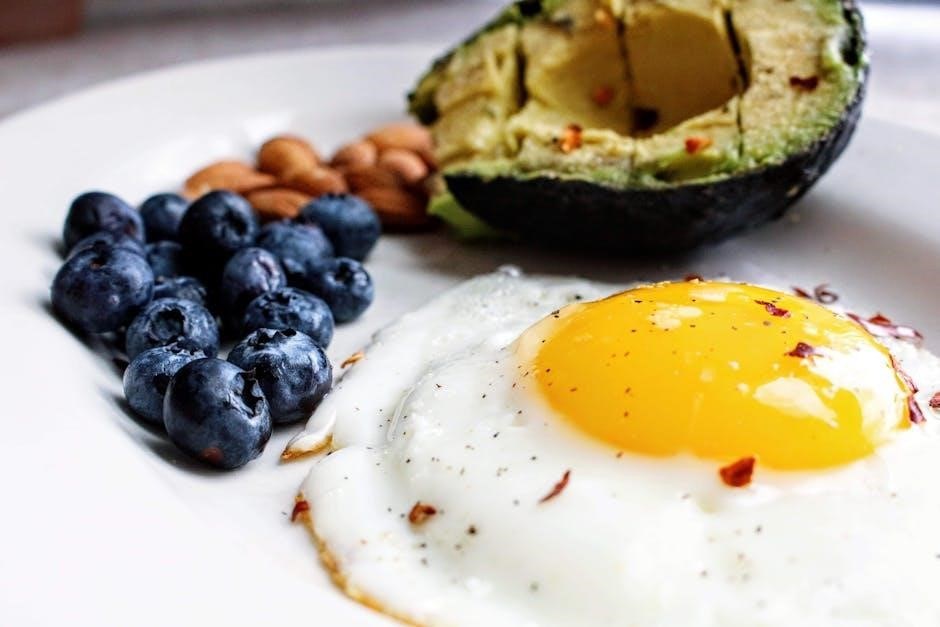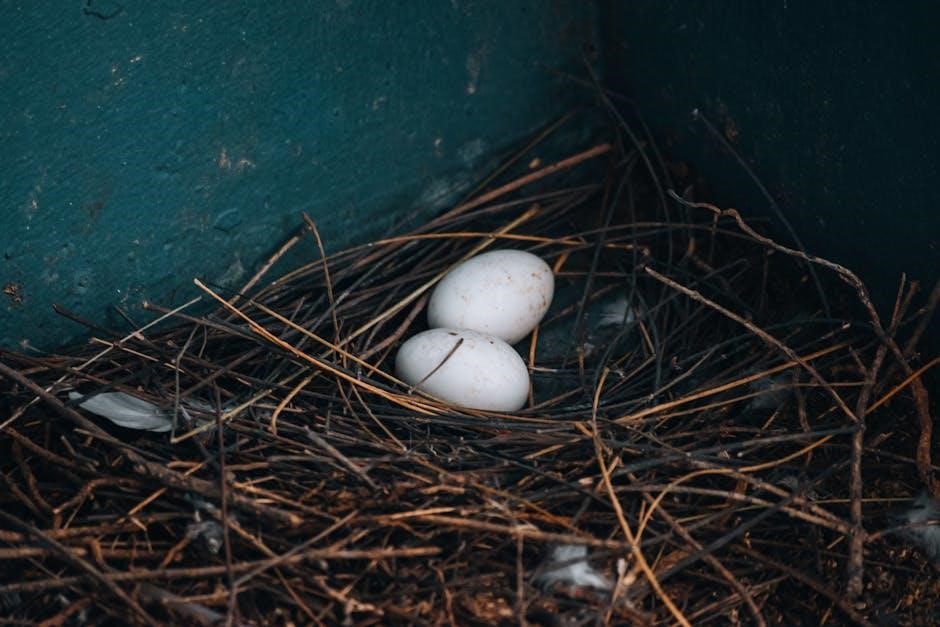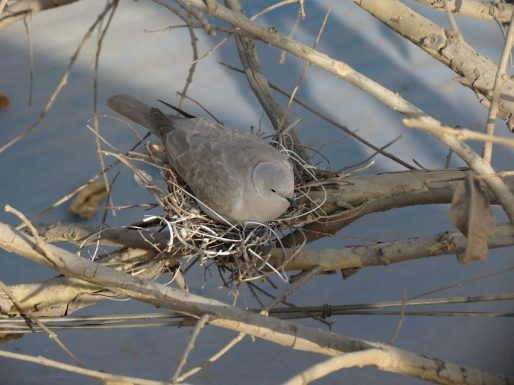This guide provides a comprehensive overview of egg incubator instructions, covering setup, maintenance, and post-hatch care. Follow these steps to ensure successful hatching and healthy chicks. Essential for beginners and experienced breeders alike, this manual guarantees optimal incubation conditions every time.
Understanding the Basics of Egg Incubation
Egg incubation involves creating a controlled environment to replicate natural conditions for embryo development. Temperature, humidity, and egg turning are critical factors. The ideal temperature for chicken eggs is 37.9°C (99.5°F), with humidity levels between 50-55%. Eggs must be turned 2-3 times daily to ensure proper embryo development. Proper placement of eggs, with the larger end up, is essential for airflow and drainage. Calibration of the incubator ensures accurate temperature and humidity control. Regular monitoring and maintenance are vital to prevent fluctuations that could harm the embryos. Understanding these basics helps ensure successful hatching and healthy chicks. Always follow specific instructions for your incubator model to achieve optimal results.
Importance of Following Proper Incubator Instructions
Adhering to incubator instructions is crucial for successful hatching and chick health. Deviation from guidelines can lead to poor hatch rates or embryo malformation. Proper temperature, humidity, and turning protocols ensure optimal conditions. Incorrect settings or neglecting maintenance can cause temperature fluctuations, affecting embryo development. Following instructions also prevents over-humidification, which can lead to chicks drowning in their shells. Additionally, timely monitoring and adjustments ensure early detection of issues. By strictly following the manual, you minimize risks and maximize the chances of healthy, thriving chicks. Consistency and attention to detail are key to achieving the best possible outcomes in egg incubation.

Preparing the Egg Incubator
Before use, ensure your incubator is clean, calibrated, and preheated. Set the temperature to 37.9°C (99.5°F) and humidity to 50-55% for optimal conditions. Follow the manufacturer’s setup guide meticulously to guarantee precise performance and successful hatching. Always sanitize all surfaces to prevent contamination and ensure a healthy environment for embryo development. Proper preparation is the foundation of a successful incubation process. Double-check all settings and functions before placing eggs inside to maximize hatch rates and chick health.
Choosing the Right Incubator for Your Needs
Selecting the appropriate incubator is crucial for successful hatching. Consider the number of eggs you plan to incubate, as incubators vary in capacity. Manual, automatic, or homemade setups are options, depending on your preference and expertise. Automatic incubators simplify the process with features like temperature control and egg turning. If you prefer a hands-on approach, manual models require regular monitoring. Ensure the incubator is easy to clean and maintain to prevent contamination. Research reviews and product descriptions to find one that suits your specific needs. Always check for features like precise temperature regulation and humidity control to ensure optimal conditions for embryo development. Choose wisely to maximize hatch rates and chick health.
Setting Up the Incubator Before Use
Before starting, unbox and inspect the incubator to ensure all components are included and undamaged. Wash your hands thoroughly to avoid contamination. Assemble the incubator according to the manufacturer’s instructions, ensuring proper alignment of trays and motors. Plug in the device and allow it to reach the optimal temperature of 100.5°F (38°C) with 50-55% humidity. Place the eggs in the incubator with the pointed end facing down. Set the timer and ensure the automatic turning feature is activated. Double-check that all settings are correct before closing the lid. Proper setup ensures a stable environment for embryo development. Always follow safety guidelines to avoid overheating or contamination risks. Once everything is ready, the incubation process can begin seamlessly.
Calibrating the Incubator for Optimal Conditions
Calibrating your incubator ensures precise temperature and humidity control, crucial for successful hatching. Start by plugging in the incubator and allowing it to preheat for 24 hours. Use a hygrometer and thermometer to verify accuracy. Adjust the temperature to 100.5°F (38°C) and humidity to 50-55%. Test the incubator’s stability by monitoring these levels for 24 hours. Fine-tune the settings as needed to maintain consistency. Regularly check and recalibrate during the incubation period to ensure optimal conditions. Proper calibration prevents overheating or underheating, which can harm embryo development. Always refer to the user manual for specific calibration instructions tailored to your incubator model. Accurate calibration is the foundation of a successful hatch.

Setting Up the Incubation Environment
Set the incubator to 100.5°F (38°C) with 50-55% humidity. Place eggs narrow-end down, ensuring proper air circulation. Monitor and adjust conditions as needed for optimal embryo development.
Adjusting the Temperature for Successful Hatching
Set the incubator to 100.5°F (38°C) for optimal hatching conditions. This temperature ensures proper embryo development and prevents issues like slow growth or developmental problems. Use the incubator’s temperature control to achieve this setting, ensuring stability. Fluctuations can harm the eggs, so monitor the display regularly. Calibrate the incubator before adding eggs to guarantee accuracy. Place a hygrometer inside to cross-check humidity levels. Maintain this temperature throughout the incubation period, as deviations can lead to poor hatch rates or malformed chicks. Refer to your incubator’s manual for specific calibration instructions, and ensure the unit is placed in a stable environment away from drafts or extreme temperatures. Consistency is key to successful hatching.
Maintaining Proper Humidity Levels
Maintaining proper humidity levels is critical for successful egg incubation. Set the incubator to 50-55% humidity during the first 18 days and increase to 70-75% during hatching. Use the incubator’s water trays to achieve these levels, as dry conditions can cause dehydration and poor hatch rates. Check humidity daily and refill water as needed to prevent fluctuations. Avoid extreme humidity, as it can lead to chick abnormalities or unsuccessful hatching. Ensure the incubator’s hygrometer is accurate for reliable readings. By maintaining consistent humidity, you create an ideal environment for embryo development and successful hatching. Proper humidity control is essential for healthy chick growth and development throughout the incubation process.
Placing Eggs in the Incubator Correctly
When placing eggs in the incubator, position them with the larger end facing up and the narrower end facing down. This ensures proper air sac development. Gently set the eggs in the incubator’s egg tray, avoiding any force that could damage the shell. Before placement, allow the eggs to warm to room temperature to prevent thermal shock. Once positioned, check that the eggs are securely held and evenly distributed to maintain consistent incubation conditions. Properly placing the eggs is crucial for optimal embryo development and successful hatching. Always follow the manufacturer’s guidelines for egg orientation and placement to ensure the best results for your incubation process.

The Incubation Process
The incubation process involves carefully monitoring temperature, humidity, and egg turning to ensure optimal embryo development. This critical phase requires precise attention to detail for successful hatching. Regular checks and adjustments are essential to maintain stable conditions throughout the incubation period, typically lasting 21 days for chicken eggs. Consistency and patience are key to achieving a high hatch rate and healthy chicks.
Understanding the Incubation Timeline
The incubation timeline is a crucial aspect of successful hatching. For most poultry eggs, the process lasts approximately 21 days, divided into three stages: early development (days 1-7), mid-incubation (days 8-14), and pre-hatch (days 15-21). During the first week, embryos develop rapidly, requiring consistent temperature and humidity. By day 7, fertilized eggs show visible signs of life through candling. From days 8 to 14, the embryo grows significantly, and the egg’s air sac expands. The final week is critical, as the chick prepares to hatch, absorbing the yolk and positioning itself to pip. Monitoring each stage ensures optimal conditions for a successful hatch. Stay attentive to these milestones to maximize hatch rates and chick health.
Turning Eggs Manually or Automatically
Egg turning is essential for even embryo development and preventing the yolk from adhering to the shell. Automatic incubators feature built-in turners that gently rotate eggs at set intervals, typically every 4-6 hours. For manual turning, eggs should be rotated 2-3 times daily, preferably in the morning, afternoon, and evening. Always handle eggs with clean hands to avoid contamination. When turning, ensure the larger end remains upright to maintain the embryo’s position. Some incubators allow adjusting the turning frequency, while others require manual intervention. Consistency is key, as irregular turning can lead to developmental issues. Choose the method that suits your schedule and incubator type for optimal results.
Monitoring Egg Development During Incubation
Regularly monitoring egg development ensures a successful hatch. Candling, a process where eggs are illuminated to observe internal growth, should be done on days 7-10 and 18 of incubation. This helps identify fertile eggs, detect issues like cracks, and track embryo progress. Use a candler or a bright light in a dark room to view the eggs. Look for visible blood vessels and a darkened area indicating growth. Avoid over-handling eggs during candling to prevent stress. Record observations to track development and ensure conditions remain stable. Monitoring allows early detection of potential issues, enabling timely adjustments for optimal hatching success.

Hatching and Post-Hatch Care
Recognize hatching signs like pip sounds and cracks. Assist gently if needed. After hatching, ensure chicks stay warm and hydrated. Provide food and a safe environment. Careful post-hatch care ensures healthy, thriving chicks.
Recognizing Signs of Hatching
As hatching approaches, listen for faint tapping or “pipping” sounds and observe small cracks in the eggshell. The chick will start breaking through, a process called “zipping,” where it circles the shell. Ensure the incubator remains undisturbed during this critical phase. After the chick emerges, it will dry and fluff up. Avoid assisting unless necessary, as it may harm the chick. Once fully hatched, transfer the chick to a warm, safe environment. Monitor for any signs of distress or difficulty. Proper observation ensures a successful and stress-free hatching process for both the chick and the breeder. Patience is key during this delicate stage.
Assisting with the Hatching Process
Assisting during hatching should only be done if necessary, as improper handling can harm the chick. If a chick is visibly struggling to emerge, gently remove small pieces of shell with sterile tweezers. Ensure the incubator maintains proper temperature (99.5°F) and humidity (50-60%) during this process. Avoid over-assisting, as the chick needs to break free partially on its own to develop strength. If the chick is fully emerged but still wet, allow it to dry in the incubator before moving it. Always wash hands before handling eggs or chicks to prevent contamination. Intervention should be minimal and done with extreme care to ensure the chick’s safety and health.
Caring for Newly Hatched Chicks
After hatching, chicks need immediate care to thrive. Place them in a warm, draft-free environment with a heat source, such as a brooder, set to 90-95°F. Ensure access to fresh water and starter feed with 18-20% protein. Clean the brooder regularly to prevent disease. Monitor chicks for signs of illness, such as lethargy or labored breathing. Handle chicks gently to avoid stress. Provide adequate ventilation to maintain air quality. Gradually reduce heat by 5°F each week as chicks grow. Keep the environment humid to prevent dehydration. Ensure chicks are active, fluffy, and vocal, as these are signs of good health. Proper care during the first few weeks is crucial for their survival and growth.

Maintenance and Troubleshooting
Regularly clean and sanitize the incubator to prevent contamination. Check temperature and humidity settings, and reset timers as needed. Address issues promptly for optimal incubation results.
Cleaning and Sanitizing the Incubator
Proper cleaning and sanitizing of the incubator are crucial for successful hatching and preventing contamination. Start by turning off the incubator and allowing it to cool. Use a soft, damp cloth to wipe down all surfaces, removing any dirt, dust, or residue. For tougher stains, mix a mild detergent with warm water, but avoid harsh chemicals that could damage the unit. Rinse thoroughly and dry with a clean towel to prevent bacterial growth. Pay special attention to water trays, egg holders, and vents, as these areas are prone to moisture buildup. Regular sanitizing ensures a healthy environment for your eggs and chicks. Always follow the manufacturer’s guidelines for cleaning products. Sanitize before and after each use to maintain optimal conditions for incubation.
Troubleshooting Common Incubation Issues
Identifying and resolving issues during incubation is key to successful hatching. Common problems include temperature fluctuations, poor egg quality, or incorrect humidity levels. If the incubator temperature is too high or low, check the sensor accuracy and recalibrate if necessary. For poor hatch rates, ensure eggs were stored correctly before incubation and verify their freshness. Humidity issues can cause eggs to dry out; adjust water levels in trays and ensure proper ventilation. If eggs are not developing evenly, inspect for cracks or damage. Power outages may disrupt incubation; consider using a backup generator. Always refer to your incubator’s manual for model-specific troubleshooting tips. Addressing these issues promptly ensures healthy development and successful hatching.
Mastering egg incubator instructions ensures a successful hatching process and healthy chicks. By following proper setup, maintenance, and care procedures, you can optimize incubation conditions. Remember to monitor temperature, humidity, and egg turning meticulously. Addressing common issues promptly and maintaining a clean environment are crucial. Refer to your incubator’s manual for specific guidelines, as different models may vary. With patience and attention to detail, you’ll achieve rewarding results. Whether you’re a seasoned breeder or a newcomer, these instructions provide a clear path to successful incubation. Happy hatching!
